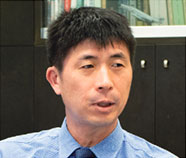About us
JAXA Aviation helps to create a safer and more prosperous society with aeronautics-related research and development activities.
FLIGHT PATH No.22 | 2018 WINTER
JAXA's Aspirations behind the Fourth Mid-to-long-term Plan
Reflecting on ideas discussed by the strategic working group
Creating new value Building on past research to make silent supersonic passenger aircraft a reality

MAKINO Yoshikazu
Director of the Aviation Systems Research Unit
One of the major themes of the Sky Frontier Program (Sky Frontier) is supersonic passenger aircraft, which was also a key focus area in the Third Mid-term Plan.
If you look around the world, you will realize that the situation with regard to supersonic transport is undergoing a major shift. For example, a number of manufacturers are developing commercial supersonic aircraft, and leading airlines are investing in this effort. The National Aeronautics and Space Administration (NASA) is developing a low-boom flight demonstrator.
JAXA's Aviation Technology Directorate has started research and development of silent supersonic transport technology ahead of others in the world. The analysis data we obtained through the D-SEND project as part of the Third Mid-term Plan have been used not only as resources for JAXA's next research and development, but also by the International Civil Aviation Organization (ICAO) as guidelines for future sonic boom standards. We'd like to contribute to Japanese aviation industries by acquiring a technological advantage for taking initiative in the future civil supersonic market through these activities.
As shown in these developments, supersonic passenger aircraft are drawing attention around the world, and this increased interest is providing a tailwind for those engaged in related research. On the other hand, this also means that we have entered the competition phase. Therefore, the issue for the supersonic transport technology research in the Fourth Mid-to-long-term Plan is what the final application will be, and how we can take the effort to the stage where Japanese aerospace industries can actually start developing an aircraft. JAXA's role is to cultivate and raise the level of new technology and hand it over to the private sector. However, we're now worried that Japanese aerospace industries might end up getting left behind in the global competition if we cannot make sure that manufacturers can utilize our technology to immediately start developing aircraft.
With this sense of urgency, members of the Sky Frontier Program (Sky Frontier) had a common understanding that we have to engage in research and development with a new approach, one that is more specifically targeted to practical application. Therefore, we explained that in the strategic working group we would aim to achieve system integration of silent supersonic aircraft technologies that incorporate everything we've worked on so far, such as the low-sonic boom technology we studied in the D-SEND project, as well as low-drag and low-noise technologies, then demonstrate these technologies before passing them on to manufacturers. We would like to engage in research to make silent supersonic passenger aircraft a reality building on the considerable amount of work that JAXA has done over the years.

JAXA's small silent supersonic passenger aircraft (conceptual image)
Do you have any research goals other than system integration of silent supersonic aircraft technologies in the Fourth Mid-to-long-term Plan?
In the Sky Frontier Program (Sky Frontier), we plan to continue our research on a hybrid propulsion system for future electric aircraft and future-generation rotary-wing aircraft systems like high-speed compound helicopters, in addition to system integration of silent supersonic aircraft technologies, taking up where we left off in the Third Mid-term Plan.
We anticipate new research topics outside the realm of the Sky Frontier Program (Sky Frontier) as well. One example would be research on fuel-efficient, low-noise transonic and subsonic aircraft, which is basically where we are aiming toward in our work on the Eco-wing technology and the FQUROH project . The Eco-wing technology is the subject of one of the R&D activities in the Environment-Conscious Aircraft Technology (ECAT) program. The research we're doing in this program on technologies for designing innovative concepts of aircraft to achieve low fuel consumption and low noise, including application of new technologies such as laminar airfoil and riblets, should be pursued in collaboration with the Sky Frontier Program (Sky Frontier). In areas like this where cross-program approach is required, basic and fundamental research is indispensable. In future challenges, I believe we would be called on not just to merge different program areas but also to incorporate aeronautical science and basic technology research.
A totally new technology that has not existed in the aviation field might appear one day and become a major game changer for the aviation industry. In order to compete globally in such an environment, we need new breakthrough technologies. In the Fourth Mid-to-long-term Plan, we will continue our efforts to develop new technologies.
JAXA's Aspirations behind the Fourth Mid-to-long-term Plan
Reflecting on ideas discussed by the strategic working group
- Toward broader social implementation, stronger fundamental research base, and creation of new value that provides innovative solutions to existing issues
- Accelerating core engine technology research
- Using integrated simulation technologies to solve complicated multidisciplinary problems
- Building on past research to make silent supersonic passenger aircraft a reality